

Some of the best images of Saturn are shown here. They all used the AO-2 adaptive optics system, and show nearly diffraction-limited images taken during good seeing in San Diego.
These images were taken with a 9" planetary Newtonian, projected to F/60 (14.1 m EFL), and an SBIG ST-7 CCD camera and CFW-8 color filter wheel.
A movie, compressing half of a Saturn day into about 5 seconds, was made to show the moons orbiting Saturn. Its a 2 MB file, so be prepared to download the movie by clicking here - its well worth the download time!
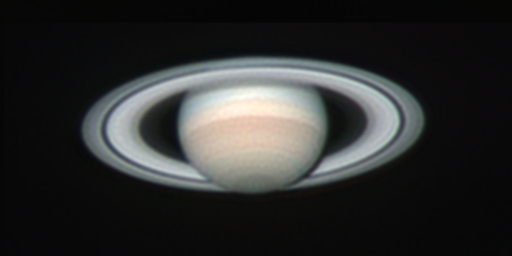
Saturn, December 30, 2000. Magnitude 0.0, 19.8 arcsec diameter. This was the best taken during this season, using the AO-2 at F/60. This is an L-RGB image; the color frames were taken through RGB color images at 2x binning, each exposure lasting 2 seconds. The monochrome (Luminance) image was taken without binning through a clear filter, so the exposure could be kept at 2 seconds. Each color frame is the sum of 4 images, while the monochrome is the sum of the best 5 frames. MaxImDL maximum entropy deconvolution was used as gently as possible to prevent generation of any spurious artifacts. The minimum unsharp masking was then used to increase the contrast.
The image shows some high-resolution details. The inner edge of the A ring is slightly brighter near the Cassini gap, as also shown in Hubble images. The inner portion of the B ring is also dimmer, before it fades into the C ring (shown below). The planet is dimly seen through the A ring to the top, as well as through the C ring. The planet's shadow on the rings is very distinct.
There is a hint of the Enke division about 80% of the way out on the A ring, and care was taken to make sure it was not an artifact of the sharpening algorithms. Until better images are taken, however, the division is just "indicated", not "proven". Some loss of image quality was taken when the image was converted to jpeg format.
The difficulty of combining multiple images of an extended object are shown in this short movie, taken on February 3, 2001. While each image is pretty good by itself, perfect correlation over the entire image is not possible; this is due to the effect called "anisoplanitism" in adaptive optics research. For extended objects, different parts of the object travel through different atmospheric paths, giving slightly different distortions. In effect, ripples due to high-altitude winds cause ripples in the image. If each image exposure is short enough, detail will be preserved, but not necessarily in perfect geometry. Thus, adding many short exposure images will cause the same blur as a single long-exposure image, as long as the images are simply aligned to a best image.
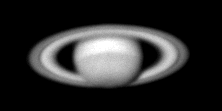
(If Saturn's rings are not in motion, please activate the movie option in your browser.)
Saturn images taken February 3, 2001. Each image was one second long through a clear filter, so each image already contains some image blurring. The ST-7 images were taken with 2x binning, then sharpened through MaxImDL processing. The 8 frames in the movie are not consecutive, but were chosen as the sharpest.
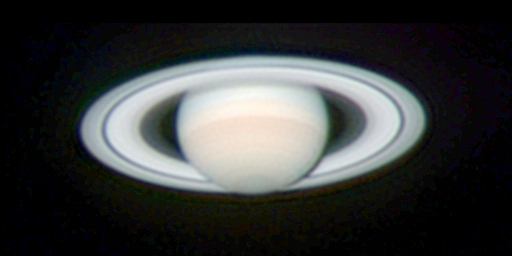
Saturn, December 30, 2000. This is the same color image shown above, but with the image stretched to show the inner C ring. The gray ring is easily visible against the black background of space, but is also visible against the planet at the top, giving a 3-dimensional effect.

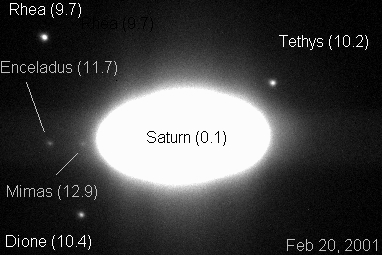
Saturn February 20, 2001. The top image is the sum of 5 images, each image 2 seconds long, selected for the best resolution. Since Saturn's moons move pretty quickly, the moons show up as 5 dots when that image is stretched. The bottom image is a single 10 second exposure, stretched to show 5 of the moons. The magnitude of each object is shown for each object. Note that Mimas, only 27 arcsec away, is about 130,000 times dimmer, yet is perfectly located; a tribute to CCD imaging!
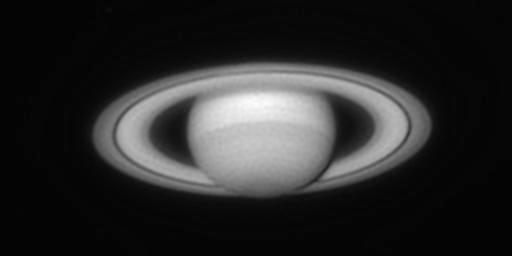
January 6, 2001
Good seeing, so I took a number of images at different exposures and with different filters, to help determine the best combinations for the highest possible resolution. I tried a clear filter which passed all the IR light; this made the image brighter, but I expected that chromatic aberration over the entire CCD spectral band would limit resolution (the AO-2 uses several achromatic lenses). I tried some exposures with a green filter, which required longer exposures. Sorting through all the images, I also tried combining the very best images to help reduce noise. The best result is shown above. It is a single 10 second exposure through the green filter! Second place, with slightly less resolution, but much less noise, was the sum of five 4-second exposures through a green filter. Third place goes to a single 4-second exposure through the clear filter. All of the 1 and 2 second exposures were just too noisy, and were difficult to align to achieve higher resolution. These images were taken without binning, so each pixel represents only 0.13 arcseconds. The Cassini division is about 5 pixels wide, representing 0.65 arcseconds, just as it should be!
Just after this exposure, I took a number of 0.5 second exposures of the Airy disk of a bright star to compose into a movie. Go back to the Image Gallery page and select the stellar images area to see what the seeing was like when this Saturn image was taken. This image is composed of a 10 second exposure, so you can see how much luck is involved to get a diffraction limited image in these seeing conditions!
All text and images are owned by Stellar Products, 1992-2003. Any use by others without permission of Stellar Products is prohibited.
Links to other Stellar Products pages:
Stellar Products Image Gallery
About Stellar Products